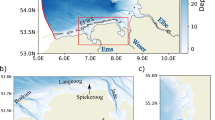Abstract
Seagrass and seaweed beds play important roles in coastal marine ecosystems. They are food sources and habitats for many marine organisms, and influence the physical, chemical, and biological environment. They are sensitive to human impacts such as reclamation and pollution. Therefore, their management and preservation are necessary for a healthy coastal environment. Satellite remote sensing is a useful tool for mapping and monitoring seagrass beds. The efficiency of seagrass mapping, seagrass bed classification in particular, has been evaluated by mapping accuracy using an error matrix. However, mapping accuracies are influenced by coastal environments such as seawater transparency, bathymetry, and substrate type. Coastal management requires sufficient accuracy and an understanding of mapping limitations for monitoring coastal habitats including seagrass beds. Previous studies are mainly based on case studies in specific regions and seasons. Extensive data are required to generalise assessments of classification accuracy from case studies, which has proven difficult. This study aims to build a simulator based on a radiative transfer model to produce modelled satellite images and assess the visual detectability of seagrass beds under different transparencies and seagrass coverages, as well as to examine mapping limitations and classification accuracy. Our simulations led to the development of a model of water transparency and the mapping of depth limits and indicated the possibility for seagrass density mapping under certain ideal conditions. The results show that modelling satellite images is useful in evaluating the accuracy of classification and that establishing seagrass bed monitoring by remote sensing is a reliable tool.
Similar content being viewed by others
References
Komatsu T (1996) Influence of a Zostera bed on the spatial distribution of water flow over a broad geographical area. In: Kuo J, Phillips RC, Walker DI, Kirkman H (ed) Seagrass biology: Proceedings of an International Workshop. The University of Western Australia, Perth, pp 111–116
Komatsu T, Kawai H (1986) Diurnal changes of pH distributions and the cascading of shore water in a Sargassum forest. J Oceanogr Soc Japan 42:447–458.
Komatsu T, Yamano H (2000) Influence of seagrass vegetation on bottom topography and sediment distribution on a small spatial scale in the Dravuni Island Lagoon, Fiji. Biol Mar Medit 7:243–246
Komatsu T, AriyamaH, Nakahara H, Sakamoto W (1982) Spatial and temporal distributions of water temperature in a Sargassum forest. J Oceanogr Soc Japan 38:63–72
Komatsu T, Sagawa T, Sawayama S, Tanoue H, Mohri A, Sakanishi Y (2012) Mapping is a key for sustainable development of coastal waters: examples of seagrass beds and aquaculture facilities in Japan with use of ALOS images. In: Ghenai C (ed) Sustainable development. Intech Publishing Co, Rijeka, Croatia, pp 145–160
Lyzenga DR (1978) Passive remote-sensing techniques for mapping water depth and Bottom Features. Appl Optics 17:379–383
Lyzenga DR, Malinas P, Tanis FJ (2006) Multispectral bathymetry using a simple physically based algorithm. IEEE Trans Geosc Remote Sens 44:2251–2259
Mumby PJ, Edwards AJ (2002) Mapping marine environments with IKONOS imagery: enhanced spatial resolution can deliver greater thematic accuracy. Remote Sens Environ 82:248–257
Mumby PJ, Green EP (2000) Field Survey: building the link between image and reality. In: Edwards AJ (ed) Remote sensing handbook for tropical coastal management. UNESCO, Paris, pp 57–66
Orth RJ, Carruthers TJB, Dennison WC, Duarte CM, Fourqurean JW, Heck KL, Hughes AR, Kendrick GA, Kenworthy WJ, Olyaenik S, Short FT, Waycott M, Williams SL (2006) A grobal crisis for seagrass ecosystems. Bioscience 56:987–996
Pasqualini V, PergentMC, Pergent G, Agreil M, Skoufas G, Sourbes L, Tsirika A (2005) Use of SPOT 5 for mapping seagrasses: an application to Posidonia oceanica. Remote Sens Environ 94:39–45
Sagawa T, Boisnier E, Komatsu T, Mustapha KB, Hattour A, Kosaka N, Miyazaki S (2010) Using bottom surface reflectance to map coastal marine areas: a new application method for Lyzenga’s model. Int J Remote Sens 31:3051–3064
Sagawa T, Mikami A, Komatsu T, Kosaka N, Kosako A, Miyazaki S, Takahashi M (2008) Mapping seagrass beds using IKONOS satellite image and side scan sonar measurements: a Japanese case study. Int J Remote Sens 29:281–291
Sagawa T, Mikami A, Aoki NM, Komatsu T (2012) Mapping seaweed forests with IKONOS image based on bottom surface reflectance. In: Proceedings of the SPIE Asia-Pasific Remote Sensing, pp 1–7
Stumpf RP, Holderied K (2003) Determination of water depth with high-resolution satellite imagery over variable bottom types. Limnol Oceanogr 48:547–556
Taylor M (2009) IKONOS planetary reflectance and mean solar exoatmospheric irradiance. IKONOS Planetary Reflectance, QSOL Rev. 2
Walker DA, McComb AJ (1992) Seagrass degradation in Austrarian castal waters. Mar Pollut Bull 25:191–195
Author information
Authors and Affiliations
Corresponding author
Rights and permissions
About this article
Cite this article
Sagawa, T., Komatsu, T. Simulation of seagrass bed mapping by satellite images based on the radiative transfer model. Ocean Sci. J. 50, 335–342 (2015). https://doi.org/10.1007/s12601-015-0031-3
Received:
Revised:
Accepted:
Published:
Issue Date:
DOI: https://doi.org/10.1007/s12601-015-0031-3




